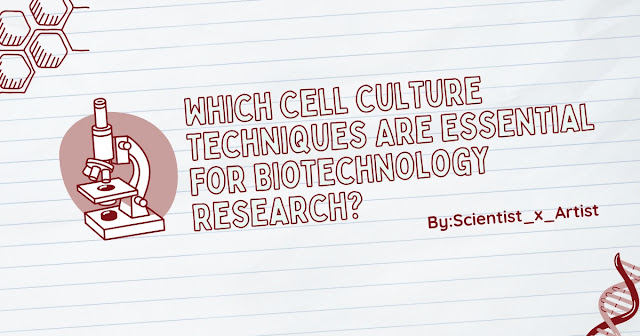In biotechnology research, cell culture is an essential technique that is widely used and applied. This technique allows researchers to test medications, create biologics, and examine cellular behaviors in a controlled setting.
Cells are grown under exacting laboratory conditions, that
are exclusively designed according to the nature and type of culture, away from
their natural habitat. Developing these skills is essential for advances in
industrial biotechnology, agricultural biotechnology, and medicinalbiotechnology.
Every biotechnology practitioner should be familiar with the fundamental cell culture procedures in order to excel in a biotechnology lab.
This blog is your ultimate
guide to cell culture techniques that are essential for biotechnology research.
1. Aseptic Techniques
Sterile culture is the cornerstone of a good cell culture. Therefore, the sterility of the culture must be ensured throughout the experiment. Microorganism contamination can jeopardize investigations, which is why aseptic methods are essential.
Key Practices:
· Using 70% ethanol to disinfect work surfaces.
· Using sterile instruments, gloves, and reagents; utilizing laminar flow hoods to avoid contamination.
Aseptic techniques guarantee the accuracy and consistency of test findings. It also ensures the credibility of experiments being performed in a biotechnology lab.
2. Cell Line Selection and Maintenance
For precise and significant results, selecting the appropriate cell line and keeping it healthy is essential.
Cell line selection and maintenance is important because it ensures that experimental models are consistent.
Steps Involved:
· You can employ primary cells that have been directly extracted from tissues or immortalised cell lines (like HeLa or CHO), depending on the topic of your study.
· Sub-culturing /Passaging: it is a technique that involves moving cells to fresh flasks to preserve vitality and avoid over-confluency.
·
To
preserve genetic stability for later use, cells are cryopreserved in liquid
nitrogen.
3. Media Preparation and Optimization
For cells to survive and proliferate, culture medium provides them with vital nutrients, growth factors, and the right pH.
Both excellent cell growth and experimental precision are supported by properly
prepared medium. Therefore, it is necessary to use and prepare the media that
is suitable for your culture.
Types of Media:
- Basal Media:
Different Media Types that are used in biotechnology lab are DMEM, RPMI,
and MEM are examples of basic media that are customised for particular
cell lines.
- Serum-Supplemented Media: By supplying proteins and hormones, fetal bovine serum (FBS)
promotes growth of the cell lines present in the culture medium.
- Serum-Free Media: Research requiring specific conditions or therapeutic applications uses serum-free media.
4. Monitoring and Assessing Cell Viability
Monitoring cell health on a regular basis is of prime importance. This step guarantees that studies are carried out on living, growing cells and the cell culture is growing without any visible contamination or disruption.
Important Methods:
· Examine the morphology and confluency of cells at the microscopic level.
· Performing Trypan Blue Exclusion Test. In this test staining dead cells blue indicates vitality.
· MTT Assay: Determines viability by measuring metabolic activity of the culture.
Monitoring and assessing cell viability is important as it reduces variability by ensuring that only healthy cells are used in experiments.
5. Cell Transfection
To investigate gene function or create therapeutic proteins,
cell transfection involves introducing foreign DNA, RNA, or proteins into
cells.
Techniques:
- Chemical transfection is the process of delivering nucleic acids using substances such as lipofectamine.
- Electroporation: The process of briefly permeabilizing the cell membrane by applying an electric field.
- Viral transduction: the introduction of genetic material via viruses as
vectors.
It is important for research on protein synthesis, gene therapy, and genetic engineering.
Methods:
- Chemical Transfection: Chemical transfection is the process of delivering nucleic acids using substances such as lipofectamine.
- Electroporation:
The process of briefly permeabilizing the cell membrane by applying an
electric field is termed as electroporation. This allows the target
material to easily bypass the cell membrane.
- Viral Transduction: The introduction of genetic material via viruses as vectors is known as viral transduction. In this method viral DNA is used as a carrier to transfer gene of interest.
6. Co-Culture Systems
Growing two or more cell types together to replicate the in vivo environment is known as co-culture. It provides more biologically significant information than monocultures, hence it is very important.
Applications:
- Researching interactions between cells, such as those between tumors and the stroma.
- Drug testing in systems that comprises of many cells.
-
Simulating intricate
systems, such as the blood-brain barrier.
7. 3D Cell Cultures and Organoids
The natural cellular milieu is frequently not replicated by conventional 2D cultures. A more realistic model is offered by 3D cultures and organoids that are now been widely used in biotechnology laboratories.
3D Cell cultures and organoids has now transformed various fields in biotechnology that icludes tissue engineering, cancer research, and drug development by simulating in vivo circumstances.
Techniques:
Following are the techniques used in 3D Cell cultures and organoids formation.
·
Spheroid
Culture: In spheroid Culture, Clusters of
cells self-assemble into spheres.
· Organoid Formation: Stem cells develop into structures that resemble organs, these lab formed structures are called organoids.
To dive deep into the world of cell culture join me in my course today!













0 Comments